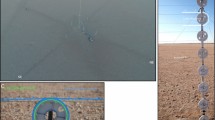Abstract
Nonperiodic vertical and temporal variations in wind direction in the lower 500-meter air layer related to synoptic conditions are studied using the long-term data of acoustic remote sensing by the MODOS sodar at Moscow State University. Average values of wind shear to the right (clockwise) with time as a result of the passage of atmospheric fronts are 55° for cold fronts, 40° for warm fronts, and 45° for occlusion fronts. In some cases the clockwise wind shear may reach 180° per 30 minutes and 720° per several hours. The wind shear to the left with time is usually observed if the northern periphery of anticyclones or the ridge axis pass by. It takes more time than the clockwise wind shear does. Dramatic variations in wind direction with height including synchronous opposite air flows at different heights are observed in the zones of fronts, axes of ridges and troughs (if they are inclined), and cols. The vertical wind shear may reach 250° in the lower 300-meter air layer. Thunderstorms in Moscow are usually accompanied by the average wind speed increase by 1 m/s during 30-40 minutes after their beginning.
Similar content being viewed by others
References
M. S. Averkiev, Meteorology (Moscow State Univ., Moscow, 1951) [in Russian].
A. A. Bachurina and Z. L. Turketti, Atmospheric Fronts (Gidrometeoizdat, Leningrad, 1952) [in Russian].
A. S. Zverev, Synoptic Meteorology (Gidrometeoizdat, Leningrad, 1977) [in Russian].
O. G. Krichak, Synoptic Meteorology (Gidrometeoizdat, Leningrad, 1956) [in Russian].
M. A. Lokoshchenko, “Wind Direction in Moscow,” Meteorol. Gidrol., No. 10 (2015) [Russ. Meteorol. Hydrol., No. 10, 40 (2015)].
M. A. Lokoshchenko and N. F. Elanskii, “Dynamics of Surface-air Pollution during the Passage of a Cold Front,” Izv. Akad. Nauk, Fiz. Atmos. Okeana, No. 2 42 2006 [Izv., Atmos. Oceanic Phys., No. 2, 42 (2006)].
Typical Characteristics of the Lower 300-meter Atmospheric Layer from the Measurements at Meteorological Tower, Ed. by N. L. Byzova (Gidrometeoizdat, Moscow, 1982) [in Russian].
S. P. Khromov, Fundamentals of Synoptic Meteorology (Gidrometeoizdat, Leningrad, 1948) [in Russian].
N. S. Shishkin, Clouds, Precipitation, and Thunderstorm Electricity (Gidrometeoizdat, Leningrad, 1964) [in Russian].
M. A. Lokoshchenko and L. I. Alekseeva, “Short-term Dynamics of the Atmospheric Boundary Layer Wind Structure in Moscow City by the Sodar Data,” in Extended Abstracts ofPresentations from the 16th International Symposium for the Advancement of Boundary-layer Remote Sensing (Boulder, Colorado, USA, 2012).
M. A. Lokoshchenko, E. A. Yavlyaeva, and H.-J. Kirtzel, “Sodar Data about Wind Profiles in Moscow City,” Meteorologische Zeitschrift, No. 3, 18 (2009).
Author information
Authors and Affiliations
Corresponding author
Additional information
Original Russian Text © M.A. Lokoshchenko, L.I. Alekseeva, K.I. Akhiyarova, 2016, published in Meteorologiya i Gidrologiya, 2016, No. 7, pp. 15-28.
About this article
Cite this article
Lokoshchenko, M.A., Alekseeva, L.I. & Akhiyarova, K.I. Relations of lower atmosphere wind dynamics to synoptic conditions and weather phenomena. Russ. Meteorol. Hydrol. 41, 455–465 (2016). https://doi.org/10.3103/S1068373916070025
Received:
Published:
Issue Date:
DOI: https://doi.org/10.3103/S1068373916070025




